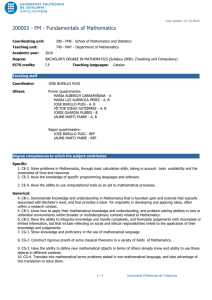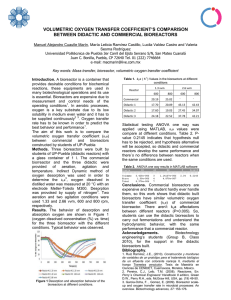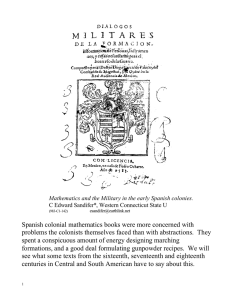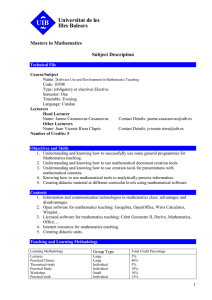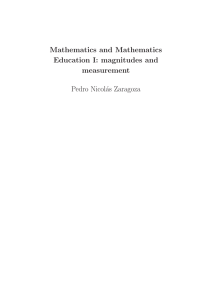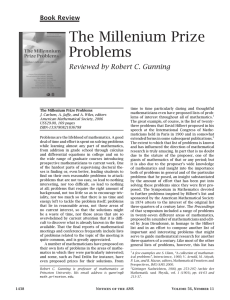didactic engineering as design-based research in mathematics
Anuncio
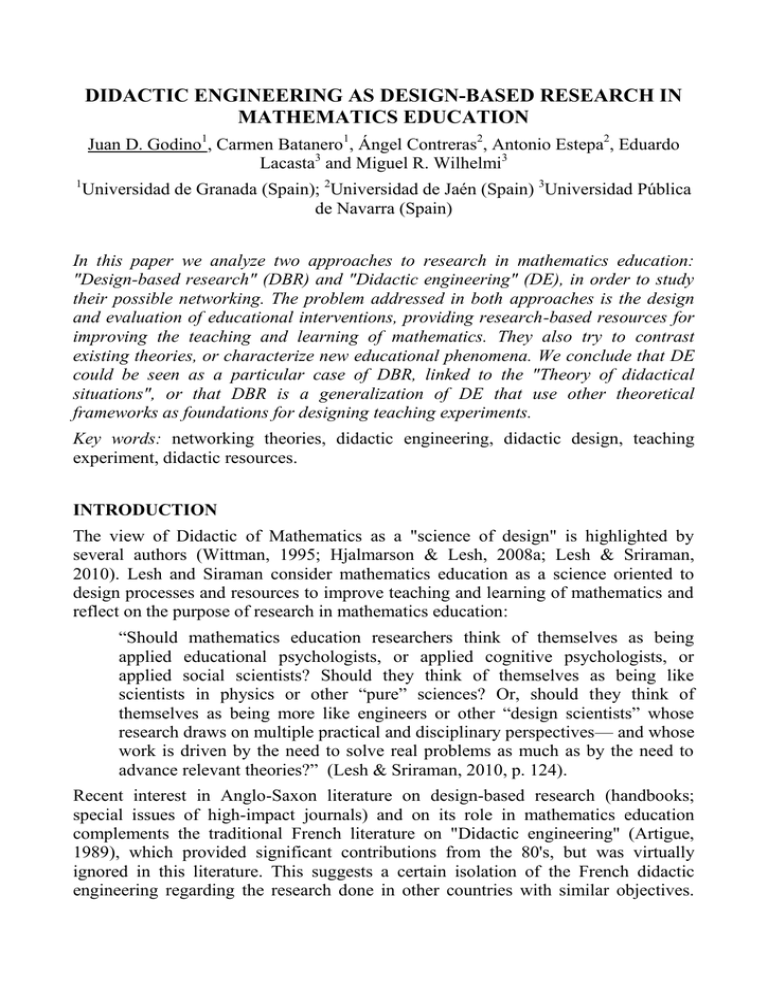
DIDACTIC ENGINEERING AS DESIGN-BASED RESEARCH IN MATHEMATICS EDUCATION Juan D. Godino1, Carmen Batanero1, Ángel Contreras2, Antonio Estepa2, Eduardo Lacasta3 and Miguel R. Wilhelmi3 1 Universidad de Granada (Spain); 2Universidad de Jaén (Spain) 3Universidad Pública de Navarra (Spain) In this paper we analyze two approaches to research in mathematics education: "Design-based research" (DBR) and "Didactic engineering" (DE), in order to study their possible networking. The problem addressed in both approaches is the design and evaluation of educational interventions, providing research-based resources for improving the teaching and learning of mathematics. They also try to contrast existing theories, or characterize new educational phenomena. We conclude that DE could be seen as a particular case of DBR, linked to the "Theory of didactical situations", or that DBR is a generalization of DE that use other theoretical frameworks as foundations for designing teaching experiments. Key words: networking theories, didactic engineering, didactic design, teaching experiment, didactic resources. INTRODUCTION The view of Didactic of Mathematics as a "science of design" is highlighted by several authors (Wittman, 1995; Hjalmarson & Lesh, 2008a; Lesh & Sriraman, 2010). Lesh and Siraman consider mathematics education as a science oriented to design processes and resources to improve teaching and learning of mathematics and reflect on the purpose of research in mathematics education: “Should mathematics education researchers think of themselves as being applied educational psychologists, or applied cognitive psychologists, or applied social scientists? Should they think of themselves as being like scientists in physics or other “pure” sciences? Or, should they think of themselves as being more like engineers or other “design scientists” whose research draws on multiple practical and disciplinary perspectives— and whose work is driven by the need to solve real problems as much as by the need to advance relevant theories?” (Lesh & Sriraman, 2010, p. 124). Recent interest in Anglo-Saxon literature on design-based research (handbooks; special issues of high-impact journals) and on its role in mathematics education complements the traditional French literature on "Didactic engineering" (Artigue, 1989), which provided significant contributions from the 80's, but was virtually ignored in this literature. This suggests a certain isolation of the French didactic engineering regarding the research done in other countries with similar objectives. The purpose of this paper is to establish some connections between both research approaches or paradigms by trying to answer the following questions: - Can didactic engineering be included within the family of design-based research? - What kind of synergies can be established between these research paradigms? The problem of comparison and coordination of theoretical frameworks is a topic of relevance discussed by various authors and in discussion forums, such as the CERME Working Group ”Different Theoretical Approaches and Perspectives in Mathematics Education Research” (Prediger, Arzarello, Bosch, & L’enfant, 2008). Bikner-Ahsbahs and Prediger (2010) make a plea for exploiting theoretical diversity as a resource for richness and consider this diversity as a challenge and starting point for further theoretical development through networking theories. In this paper we compare "Didactic engineering" (DE) and "Design-based research" (DBR), starting with the identification of their basic features and later carrying out a rational comparison of them. In the next two sections, a summary of the characteristics of DBR (Collins, Joseph, & Bielaczyc, 2004; Kelly, Lesh & Baek, 2008), and DE (Artigue, 1989; 2009, 2011) is carried out. Then we identify similarities, differences and possible complementarities in the problems addressed, the theoretical principles, methodology and intended results. DESIGN-BASED RESEARCH MAIN FEATURES Design-based research1 (DBR) (Brown, 1992; Kelly, Lesh & Baek, 2008) is a family of methodological approaches for the study of learning in context. It uses the design and systematic analysis of instructional strategies and tools, trying to insure that instructional design and research be interdependent. It is assumed that educational research separated from practice cannot take into account the context influence on the complex nature of the results, or cannot adequately identify their constraints and conditioning factors: “We argue that design-based research can help create and extend knowledge about developing, enacting, and sustaining innovative learning environments” (DBRC, 2003, p. 5). This group of authors used the term design-based research methods to differentiate their approach from the classic experimental design in teaching, attributing five characteristics to this method: 1. The central goals of designing learning environments and developing theories or “prototheories” of learning are intertwined. 2. Development and research take place through continuous cycles of design, enactment, analysis, and redesign. 3. Research on designs must lead to sharable theories that help communicate relevant implications to practitioners and other educational designers. 4. Research must account for how designs function in authentic settings. It must not only document success or failure but also focus on interactions that refine our understanding of the learning issues involved. 1 It is also known as design research or design experiments. 5. The development of such accounts relies on methods that can document and connect processes of enactment to outcomes of interest. (DBRC, 2003, p.5). As methodological paradigm, DBR, specifies how to conduct design studies, i.e. investigations of some length on educational interventions induced usually by a designed set of innovative curricular tasks and/or instructional technology. "Often, what gets designed is a whole 'learning environment' with tasks, materials, tools, notational systems, and other elements, including means for sequencing and scaffolding" (Reimann, 2011, p. 38). Usually there is no strict separation between development and theory test, but rather both are interconnected in a way reminiscent of "grounded theory" (Glaser & Strauss, 1967). However, in DBR there is no particular interest to avoid using previous theories; on the contrary it encourages theory building that incorporates elements beyond the observations. "Design experiments are conducted to develop theories, not merely to empirically tune ‘what works’" (Cobb, Confrey, diSessa, Lehrer and Schauble 2003, p. 9). DiSessa and Cobb (2004) highlight the role of theory in what they call the “ontological innovation”— the invention of new scientific categories, specifically categories that do useful work in generating, selecting among, and assessing design alternatives. Three phases are considered along a design experiment (Cobb and Gravemeijer, 2008): 1) Planning of the experiment, 2) Experimentation to support learning; 3) Retrospective analysis of the data generated along the experiment. According to Collins, Joseph and Bielacyz (2004), design experiments, incorporate two critical elements to guide us in improving educational practice: the focus of design and the evaluation of critical elements. These experiments complement other empirical methods, such as ethnographic studies, clinical research, experimental or quasi-experimental studies to assess the effects of independent variables on dependent variables. But they also pose challenges that may be common to other research on education, such as: - Difficulties arising from the complexity of real-world situations and their resistance to experimental control. - Large amounts of data arising from the need to combine ethnographic and quantitative analysis. DIDACTIC ENGINEERING MAIN FEATURES The notion of “Didactic engineering” (DE) was introduced in the French Didactic of Mathematics in the early 80's to describe a research approach in mathematics education comparable to an engineer work. When carrying out a project the engineer relies on scientific knowledge from his/her domain; he/she agrees to submit the project to scientific scrutiny, while at the same time, is forced to solve issues more complex than those of science, and therefore to address problems that science cannot yet take over (Artigue, 1989, p. 283). Since its origin, didactic engineering was fundamentally linked to educational interventions (experiments) in classrooms, usually sequences of lessons; these experiences were guided by and tried to test some theoretical ideas (Artigue, 2011, p. 20). That is, DE is conceived as the design and evaluation of theoretically justified sequences of mathematics teaching, with the intention of trigger the emergence of some educational phenomena, and to develop teaching resources scientifically tested. Considering the state of the French research in mathematics education at the beginning of the 80s, it is not surprising that the natural theoretical framework for didactic engineering was the Theory of didactical situations (TDS) (Brousseau, 1986; 1997). In fact, didactical engineering has been the privileged didactical research methodology in France. Some features of DE in its original sense are: - It is based on classroom teaching interventions, i.e. on the design, implementation, monitoring and analyzing teaching sequences. - The validation is essentially internal, based on the confrontation between a priori and a posteriori analysis (there is no external validation, based on comparison of performances in experimental and control groups). Didactic engineering addresses case studies where the following phases are distinguished (Artigue, 1989): a) Preliminary analysis b) Design and analysis a priori of teaching situations; c) Experimentation; d) A posteriori analysis and evaluation. Perrin-Glorian (2011, p. 59) suggests that didactic engineering from the beginning "is more than a research methodology: it is also intended a didactic transposition viable in the ordinary teaching". That is, the view of didactic engineering as a product is as important as the method. The evolution of didactic engineering was linked to the change of the Theory of didactical situations (TDS) itself, or the application of other theoretical models derived from the TDS, such as the Anthropological Theory of Didactics (Chevallard, 1992), or research about teachers practices. Perrin-Glorian (2011) distinguishes two types of didactic engineering according to the primary research objective: 1) didactic engineering for research aims to produce research results with experiments depending on the research question, without worrying about a possible wider dissemination of the scenarios used, 2) didactic engineering for development and training; here the short-term goal is the production of resources for teachers and for teacher training. Although didactic engineering is not uniform, because of the changes that have been introduced, some sensibilities remain: epistemological sensitivity (expressed or not in terms of fundamental situation), emphasis on building tasks, concern for the organization of a milieu that offers a strong a-didactic potential, the key role played by the a priori analysis and the insight into the validation processes. As a result didactical engineering has become an object of fuzzy contour (Artigue, 2011, p. 23). COMPARING AND RELATING BOTH METHODOLOGICAL APPROACHES In this section we try to build a bridge between didactic engineering (DE) and design research in education. Already Hjalmarson and Lesh (2008b) compared design research with engineering: “Our view of design in education research is based, in part, on the similarities and parallels to be drawn between education and engineering as fields which simultaneously seek to advance knowledge, impact human problems, and develop products for use in practice” (Hjalmarson y Lesh, 2008a, p. 526). For these authors engineering primarily involves the design and development of products that operate in systems, and includes the process of design and the tangible products of that design: The parallels between engineering design and education design begin with the nature of the systems where the products of design are used. The systems are not fixed even if they are often stable. The systems require innovation, respond to innovation (e.g., a curriculum, a piece of technology), and are changed by innovation” (Halmarson y Lesh, 2008b, p. 107). It is clear that the use in the field of education of design-based-research, and the comparison with engineering as design technology, is restricted to the "instructional design", which becomes synonymous with "didactical design". Didactical design in mathematics education, “Includes all types of ‘controlled intervention’ research into the processes of planning, delivering and evaluating concrete mathematics education. It also includes the problem of reproducibility of results from such interventions” (Winslow, 2009, p.2). There is, however, a substantial difference between DBR and DE, which is closely linked to the methodological approach provided by the interpretive framework of a didactical base-theory, as the Theory of didactical situations (TDS). The close relationship of DE with the TSD provides explicit criteria, in the design, implementation and retrospective analysis, and an orientation to test and develop the theory itself. By contrast, although design-based research has similar goals, it does not adopt specific theoretical frameworks. DBR is, therefore, a family or category of educational research perspectives bonded for the interest or focus in the design, implementation and evaluation of educational interventions in naturalistic contexts, without explicit interest in epistemological questions. “A very noticeable aspect of the design research literature is the absence of discussion of epistemological issues. In the recent Handbook of Design Research Methods in Education (Kelly et al., 2008), for instance, the word ‘epistemology’ is not even used as an indexing term, and, while the word is not totally absent from the general DBR literature, there is no serious discussion of epistemological issues” (Walker, 2011, p.53). On the contrary, in DE epistemological questions are central because they are crucial in Theory of didactical situations. While in DBR the focus is the design and search of instructional resources, DE goes further, trying to analyze the characteristics of these resources (and in general, everything that constitutes the milieu); the idea of a-didactic situation, where students are involved in solving a problem, without the direct guidance of the teacher, and the dialectic between didactic and a-didactic situations are particularly important. Although both approaches are mainly qualitative (or mixed), an important difference is the establishment in DE of a priori hypotheses (before the experience design), while DBR tends to a qualitative posture, assuming that theories emerge from the data. Although the methodology stages are very similar, there is a greater influence of the previous theory in DE that seeks explicitly validation (even if internal) of the previous hypotheses, and the previous analyses of the design are detailed and complete. In Table 1 we summarize the comparison between the DBR and the DE, considering the three key elements proposed by Radford (2008) as constituting a theory: paradigmatic issues, principles and methods. We also identify the results expected in its application. Table 1. Comparison of DBR and DE (TSD)2 DBR Paradigmatic - How to improve issues mathematics learning in realistic school contexts based on research results? - What instructional resources can be used to improve teaching and learning mathematics? Theoretical - The design is based on assumptions various interpretive frameworks - Theories emerge from the data Methodology Type: Mixed (qualitative / quantitative) Phases: - Preparation of the experiment - Experimentation - Retrospective analysis Results 2 - Instructional resources - Local emerging theories DE (TSD) - What type of problem-situations give meaning to a specific mathematical knowledge? (Fundamental situations) - What features should have the milieu to achieve the student's independent learning of a specific knowledge? (Dialectic between a-didactic and didactic situations) - The TDS guide the formulation of hypotheses about the design and the expected results - Data test the theory Type: Mixed, with positivist emphasis (nomothetic) Phases: (guided by the base-theory) - Preliminary phase - Design and a priori analysis - Experimentation - A posteriori analysis - Validation - Testing hypotheses derived from the base-theory - Fundamental situations - Instructional resources We introduce the notation DE (TSD) to indicate the dependence of the "Didactic engineering" from the Theory of Didactic Situations. This will help to express possible generalizations of didactic engineering changing the base-theory used to support the instructional design. The paradigmatic issues stated for DE (TSD) are somewhat similar to the DBR, although oriented and specified in the light of the underlying theory. The "fundamental situations" are models or representations of mathematical knowledge, i.e. characterizations of knowledge through the issues or problems for which that knowledge is an answer. The constructivist epistemological position about mathematical knowledge supporting DE, does not explicitly question an institutional relativity for that knowledge. This relativity was later highlighted by the Anthropological Theory of Didactic (ATD) (Chevallard, 1992, 1999) and the Ontosemiotic Approach (OSA) (Godino, 2002; Godino, Batanero and Font, 2007) assuming that the "raison d'être" of knowledge change in different institutions, or from its original construction in the history of mathematics, as regards its current use. Consequently, we could view DBR as an extension of DE (TSD). While the former does not have a single or preferred theoretical framework, DE rests on a theory of intermediate level, the Theory of didactical situations which provides criteria to develop mathematical situations (search of fundamental situations for specific mathematical knowledge), and also for implementing and conducting the teaching situations in seeking students’ autonomous learning. From the methodological point of view the preliminary study proposed in DE (TSD) may be a distinction, motivated and oriented by the base-theory towards the epistemological analysis of the mathematical knowledge to be taught. FINAL REMARKS As we have mentioned, the main problem of DBR is to develop instructional resources to improve the teaching and learning mathematics in naturalist school contexts, based on research. Since the research on educational interventions depends critically on the theoretical frameworks used to support the design, implementation and interpretation of results, different DBR will depend on the base-theory, or lack of theory. Therefore, we could conceive DBR as a family of methodologies or educational research approaches. Given that the aim is to develop a product based on research (curriculum, sequence of lessons, educational software, etc.), as Hjalmenson and Lesh propose, this type of research can be considered as a form of engineering inquiry. With a wider tradition, the French didactic engineering addresses a similar problem, and is supported by an explicit base-theory of intermediate level, the Theory of didactical situations. Therefore, we may consider it as an antecedent (in time) of the family of DBR, and a particular instance thereof. It is also clear that instructional designs based on theoretical models different from the Theory of didactical situations are carried out and produce varieties of designbased research. These varieties share some paradigmatic issues, theoretical assumptions, methodologies and intended results, but may differ in others, as it is indicated in Figure 1 for didactic design based on the Anthropological Theory of Didactic (ATD), the Onto-Semiotic Approach (OSA), Realistic Mathematics Education (RME) (Freudenthal, 1991; Heuvel-Panhuizen, & Wijers, 2005), or, for example, the Lesson Study in Japan (JSL) (Fernandez & Yoshida, 2004). In this scheme we also suggest to consider the expressions, DBR - Design-Based-Research, DE - Didactical Engineering, ID - Instructional Design and DD - Didactical Design, as synonymous, i.e. with equivalent meaning. Figure 1. Varieties of design-based researches All these types of didactic engineering (instructional design, didactical design, …) share similar issues. However, new analyses are needed to clarify in more detail that that carried out in this paper the methodological consequences that arise from a change in the base-theory supporting each particular engineering, and to explain the types of results that can be obtained in each case. Acknowledgment This report has been carried out in the frame of the research Project, EDU201231869, Ministry of Economy and Competitiveness (MEC), Madrid. REFERENCES Artigue, M. (1989). Ingenierie didactique. Recherches en Didactique des Mathématiques, 9 (3), 281–308. Artigue, M. (2009). Didactical design in mathematics education. In C. Winslow (Ed.), Nordic Research in Mathematics Education. Proceedingsfrom NORMA08 (p.7 - 16). Rotterdam: Sense Publishers. Artigue, M. (2011). L'ingénierie didactique: un essai de synthèse. In C. Margolinas, M. Abboud-Blanchard, L. Bueno-Ravel, N. Douek, A. Fluckiger, P. Gibel, F. Vandebrouck & F. Wozniak (Eds.), En amont et en aval des ingénieries didactiques (pp. 225-237). Grenoble: La pensée sauvage. Bikner-Ahsbahs, A., & Prediger, S. (2010). Networking of theories - an approach for exploiting the diversity of theoretical approaches. In B. Sriraman, & L. English (Eds.), Theories of mathematics education: Seeking new frontiers (pp. 483-506). New York: Springer Brousseau, G. (1986). Fondements et méthodes de la didactiques des mathématiques. Recherches en Didactique des Mathématiques, 7 (2), 33-115. Brousseau, B. (1997). Theory of didactical situations in mathematics.Dordrecht, The Netherlands: Kluwer Brown, A. L. (1992). Design experiments: Theoretical and methodological challenges in creating complex interventions in classroom settings. The Journal of the Learning Sciences, 2 (2), 141-178. Chevallard, Y. (1992). Concepts fondamentaux de la didactique: perspectives apportées par une approche anthropologique. Recherches en Didactique des Mathématiques, 12 (1), 73112. Chevallard, Y. (1999). L'analyse des pratiques enseignantes en théorie anthropologique du didactique. Recherches en Didactique des Mathématiques, 19 (2), 221-266. Cobb, P., Confrey, J., Disessa, A., Lehrer, R., & Schauble, L. (2003). Design experiment in educational research. Educational Researcher, 32(1), 9-13. Cobb, P., & Gravemeijer, K. (2008). Experimenting to support and understand learning processes. In A.E. Kelly, R.A. Lesh, & J. Y. Baek (Eds.), Handbook of design research methods in education. Innovations in science, technology, engineering and mathematics learning and teaching (pp. 68-95). Mahwah, NJ: Lawrence Erlbaum Associates. Collins, A., Joseph, D., & Bielaczyc, K. (2004). Design research: theoretical and methodological issues. The Journal of the Learning Sciences, 13 (1), 15-42. DBRC (The Design Based Research Collective) (2003). Design-based research: An emerging paradigm for educational inquiry. Educational Researcher, 32(1), 5-8. diSessa, A. A. & Cobb, P. (2004). Ontological innovation and the role of theory in design experiments. Journal of the Learning Sciences, 13(1), 77-103. Fernandez, C., & Yoshida, M. (2004). Lesson study: A case of a Japanese approach to improving instruction through school‐based teacher development. Mahwah, NJ: Lawrence Erlbaum. Freudenthal, H. (1991). Revisiting mathematics education. China Lectures. Dordrecht: Kluwer. Glaser, B., & Strauss, A. (1967). The discovery of grounded theory: strategies for qualitative research. New York: Aldine Publishing Company, Godino, J. D. (2002). Un enfoque ontológico y semiótico de la cognición matemática. Recherches en Didactiques des Mathematiques, 22 (2/3), 237-284. Godino, J. D. Batanero, C., & Font, V. (2007). The onto-semiotic approach to research in mathematics education. ZDM. The International Journal on Mathematics Education, 39 (1-2), 127-135. Heuvel-Panhuizen, M. van den, & Wijers, M. (2005). Mathematics standards and curricula in the Netherlands. ZDM. The International Journal on Mathematics Education, 37 (4), 287-307. Hjalmarson, M. A., & Lesh, R. (2008a). Design research. Engineering, systems, products, and processes for innovation. In L. D. English (Ed.), Handbook of International Research in Mathematics Education (pp. 520-534). New York: Routledge. Hjalmarson, M. A., & Lesh, R. A. (2008b). Engineering and design research. Intersections for education research and design. In A. E. Kelly, R.A. Lesh, & J. Y. Baek (Eds.) (pp. 96-110). Kelly, A. E., Lesh, R. A., & Baek, J. Y. (Eds.) (2008). Handbook of design research in methods in education.Innovations in science, technology, engineering, and mathematics learning and teaching.,New York, NY: Routledge. Lesh, R., & Sriraman, B. (2010). Re-conceptualizing mathematics education as a design science. En B. Sriraman y L. English (Eds.), Theories of mathematics education. Seeing new frontiers (pp. 123-146). Heidelberg: Springer. Perrin-Glorian, M. J. (2011). L’ingénierie didactique à l’interface de la recherche avec l’enseignement. Développement de ressources et formation des enseignants. In C. Margolinas, M. Abboud-Blanchard, L. Bueno-Ravel, N. Douek, A. Fluckiger, P. Gibel, F. Vandebrouck, & F. Wozniak (Eds.), En amont et en aval des ingénieries didactiques (pp. 57-78). Grenoble: La pensée sauvage. Prediger, S., Bikner-Ahsbahs, A., & Arzarello, F. (2008). Networking strategies and methods for connecting theoretical approaches: first steps towards a conceptual framework. ZDM. The International Journal on Mathematics Education, 40 (2), 165178. Radford, L. (2008). Connecting theories in mathematics education: challenges and possibilities. ZDM. The International Journal on Mathematics Education, 40 (2), 317327. Reimann, P. (2011). Design-based research. In L. Markauskaite, P. Freebody, & J. Irwin (Eds.). Methodological choice and design: Scholarship, policy and practice in social and educational research (pp. 37-56). New York: Springer. Walker, R. (2011). Design-Based Research: Reflections on some epistemological issues and practices. In L. Markauskaite, P. Freebody, & J. Irwin (Eds.). Methodological choice and design: Scholarship, policy and practice in social and educational research (pp. 51-56). New York: Springer. Winslow, C. (2009). Nordic research in mathematics education: From norma08 to the future. In C. Winslow (Ed.), Nordic Research in Mathematics Education. Proceedings from NORMA08 (p.1 - 4). Rotterdam: Sense Publishers. Wittman, E. C. (1995). Mathematics education as a ‘design science’. Educational Studies in Mathematics, 29 (4), 355-374.

